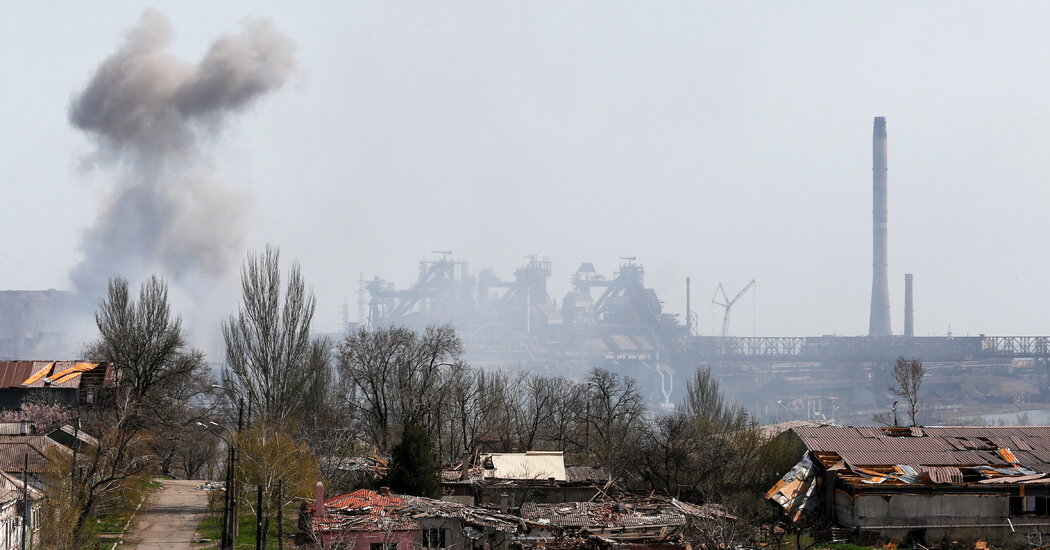Huge Steel Plant in Mariupol Is a Fortress for Ukrainian Holdouts
A sprawling Soviet-era steel factory that is sheltering thousands of soldiers and civilians is the last Ukrainian redoubt in the ravaged city of Mariupol, where the battle by Russian forces to take full control of the city appears to be entering its final stages.
Russian commanders said Tuesday they were beginning their assault on the Azovstal steel plant, where the remaining Ukrainian soldiers defending the besieged port city had been joined by 1,000 or more civilians, Ukrainian officials said. The Russians launched a new round of artillery barrages and issued the latest in a series of ultimatums to the fighters in the factory to surrender.
But the Azovstal plant makes for a formidable fortress, an immense industrial complex of thick concrete and walls, steel doors and underground warrens. Yan Gagin, who identified himself as Russian adviser in the Donetsk People’s Republic, a self-declared government backed by the Kremlin, in eastern Ukraine, said in a broadcast report that the steel factory was designed to withstand a nuclear war.
“It is basically a city under a city,” he said, conceding that the Russian’s campaign to seize the plant had been significantly hampered by the sophisticated communication systems connecting the basement levels of the plant.
Frederick W. Kagan, director of the Critical Threats project at the American Enterprise Institute, said, “I assume the Russians are going to throw everything they have at this, to eliminate this pocket.” But he said doing so could cost Moscow dearly.
The plant stretches across four square miles, a complex of buildings, smokestacks, blast furnaces and stacks of coiled and plate steel, and it has its own port facilities on the Sea of Azov.
One of the largest metal mills in Europe, it produced about 10 million tons of steel a year before the Russian invasion, most of it sent by ship to European customers, according to its owner, Metinvest, a steel and mining conglomerate owned by Ukraine’s richest man, the billionaire Rinat Akhmetov.
The network of underground spaces, which is now pivotal to the survival of the holed-up soldiers and civilians, was originally built to transport equipment between buildings and to access the undersides of ground-level machinery for maintenance, according to Metinvest, the company that operated the mill. There was no planned military use for the underground areas before the war, the company said.
The Russian military ordered Ukrainian forces inside to allow trapped civilians to evacuate through humanitarian corridors.
But the Ukrainians said they did not trust the Russians to honor their promise of safe passage and would likely refuse; they said they were preparing for battle. That sets the stage for a potentially bloody, protracted confrontation whose casualties may include many civilians.
“We are ready to fight to the last drop of blood,’’ Major Sergiy Volyna, a Ukrainian officer inside the city, wrote in a Facebook post. Major Volyna appealed to the United States and its European allies to provide Ukrainian forces with more heavy weapons. “We must know that the world has done everything possible for this.”
The Russians are trying to establish uncontested control of a swath of territory linking the separatist-held regions of Donbas, in southeastern Ukraine, to the Crimean Peninsula, which Russia seized in 2014. The holdouts in Mariupol are the last substantial obstacle left in the region.
Russia-Ukraine War: Key Developments
Russian forces have had the city, a major port, under siege since last month, bombarding much of it to rubble and slowly tightening their grip.
The fight over the Azovstal steel plant recalls one of the great struggles of the Second World War, the battle for the Stalingrad Tractor Factory as Nazi Germany’s forces attempted to capture the city. Thousands of German and Soviet soldiers died there, as did many civilians, before the Soviets ultimately prevailed.
“We’ve seen this movie before,” Mr. Kagan said. “Anytime you’re dealing with a sprawling, heavy industrial complex, it’s going to make a good fighting position for defenders.”
Ukraine’s intelligence service wrote in a statement on Monday that the Russians were preparing to use three-ton bombs on the plant in an effort to raze it completely. Moscow is “not deterred by the fact that civilians have taken refuge in the plant,” the service said in a statement, adding that they were anticipating “3-ton surprises” from the sky.
“You’d be surprised at how well people can survive big bombs in a facility like that,” said Mr. Kagan, adding that the Russians have not exhibited extraordinary precision in their targeting.
Check out our Latest News and Follow us at Facebook
Original Source







